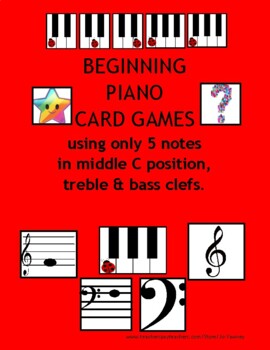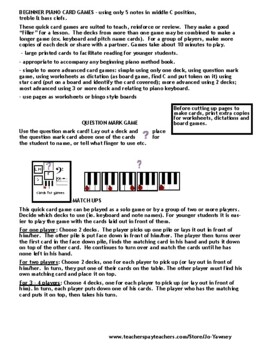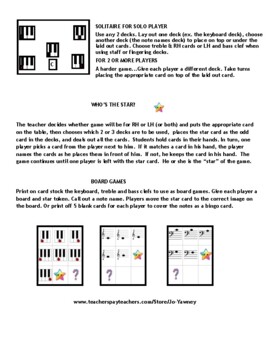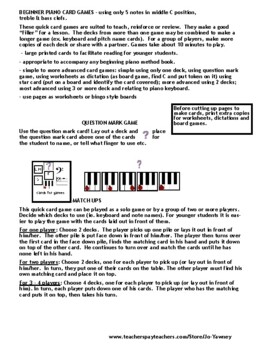BEGINNING PIANO CARD GAMES
- PDF
Description
BEGINNER PIANO CARD GAMES - using only 5 notes in middle C position, treble & bass clefs.
These quick card games are suited to teach, reinforce or review. They make a good “filler” for a lesson. The decks from more than one game may be combined to make a longer game (ex. keyboard and pitch name cards). For a group of players, make more copies of each deck or share with a partner. Games take about 10 minutes to play.
- large printed cards to facilitate reading for younger students.
- appropriate to accompany any beginning piano method book.
- simple to more advanced card games: simple using only one deck, using question mark game, using worksheets as dictation (as board game, find C and put token on it) using star card (put on a board and identify the card covered); more advanced using 2 decks; most advanced using 3 or more deck and relating to piano keyboard.
- use pages as worksheets or bingo style boards
QUESTION MARK GAME
Use the question mark card! Lay out a deck and place the question mark card above one of the cards for the student to name, or tell what finger to use etc.
MATCH UPS
This quick card game can be played as a solo game or by a group of two or more players. Decide which decks to use (ie. keyboard and note names). For younger students it is easier to play the game with the cards laid out in front of them.
For one player: Choose 2 decks. The player picks up one pile or lays it out in front of him/her. The other pile is put face down in front of him/her. The player then turns over the first card in the face down pile, finds the matching card in his hand and puts it down on top of the other card. He continues to turn over and match the cards until he has none left in his hand.
For two players: Choose 2 decks, one for each player to pick up (or lay out in front of him/her. In turn, they put one of their cards on the table. The other player must find his own matching card and place it on top.
For 3 - 4 players: Choose 4 decks, one for each player to pick up (or lay out in front of him). In turn, each player puts down one of his cards. The player who has the matching card puts it on top, then takes his turn.
SOLITAIRE FOR SOLO PLAYER
Use any 2 decks. Lay out one deck (ex. the keyboard deck), choose another deck (the note names deck) to place on top or under the laid out cards. Choose treble & RH cards or LH and bass clef when using staff or fingering decks.
FOR 2 OR MORE PLAYERS
A harder game...Give each player a different deck. Take turns placing the appropriate card on top of the laid out card.
The teacher decides whether game will be for RH or LH (or both) and puts the appropriate card on the table, then chooses which 2 or 3 decks are to be used, places the star card as the odd card in the decks, and deals out all the cards. Students hold cards in their hands. In turn, one player picks a card from the player next to him. If it matches a card in his hand, the player names the cards as he places them in front of him. If not, he keeps the card in his hand. The game continues until one player is left with the star card. He or she is the “star” of the game.
BOARD GAMES
Print on card stock the keyboard, treble and bass clefs to use as board games. Give each player a board and star token. Call out a note name. Players move the star card to the correct image on the board. Or print off 5 blank cards for each player to cover the notes as a bingo card.
Please view photos...
If you find this resource useful, please do rate it and follow me. With gratitude.





